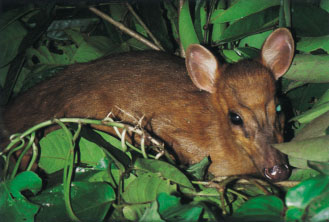
This Article From Issue
March-April 2002
Volume 90, Number 2
DOI: 10.1511/2002.10.0
Beyond the Last Village: A Journey of Discovery in Asia's Forbidden Wilderness. Alan Rabinowitz. xvi + 300 pp. Island Press, 2001. $25.
A popular genre of the 20th century was the adventure story featuring a hero who voyaged to tropical rain forests and mountain peaks to explore their mysteries. Exploration and its physical hardships brought him face to face with his inner soul and deepened his spiritual values. Outward exploration leading to inward revelation was part of what gave romantic appeal to Thor Heyerdahl's Kon-Tiki, Richard Halliburton's New Worlds to Conquer, and in the realm of fiction, W. H. Hudson's Green Mansions. Following in this grand tradition is Alan Rabinowitz's Beyond the Last Village, a narrative of his treks through the steamy rain forests of Southeast Asia and up the treacherous peaks bordering Tibet.

From Beyond the Last Village.
The book begins as a small plane carrying the author lands bumpily in Myanmar (formerly Burma). Rabinowitz, who has spent the preceding 10 years chained to a desk as director of Asia programs for the Wildlife Conservation Society, is returning to the field as a biologist. His mission is to explore whether Myanmar has any wildlife left to preserve. Its wilderness has been off- limits to Westerners for decades. After years of trying to speak with government officials about initiating a program of research and conservation there, Rabinowitz had acted quickly when an invitation arrived from the Forestry Department. He is in a race against time to save local wildlife.
The pace of this adventure story is fast and the storytelling superb. Rabinowitz is on both a scientific and a personal quest: He has left not only his desk job but also a marriage on the rocks. The perilous journey to Myanmar leads him to reflect on his life values and goals. In the process of facing internal conflicts regarding his lifework, he realizes that he does love his wife; by the end of the book a son is born and he becomes a settled and satisfied family man. The reader is gratified to find that "modern man," meeting himself in the purity of the wilderness, can gain perspective, resolve conflicts and lead a better, more peaceful life forever after. So on one level the book is a contemporary fairy tale.
But the contemporary twist—heartbreaking descriptions of paradise lost—is disturbing. Rabinowitz meets village residents so poor that their most prized commodity is salt. An Asian pygmy tribe down to its last members, faced with the reality of inbreeding, wills the ultimate extinction of their group. Slaughtered wild animals are encountered daily in the market. Regions in which large, rare mammals were abundant decades ago are now empty of wildlife.
There are brilliant moments of discovery: A delicate little deer is recognized as a new species. Expedition members view species living in the wild that they have previously seen only in museums, such as the red goral, a goat-antelope of primitive ancestry first collected in 1931. Rabinowitz's expedition documents that the black barking deer (barely known in scientific circles), the takin (a 600-pound two-horned bovid that stands almost four feet high at the shoulder), the red panda and the blue sheep still exist high in the remote mountains. The black muntjac is seen for the first time in Myanmar, more than 1,000 miles from its known range. Village residents present a gift to the expedition botanist of the wild slipper orchid, a rare black orchid seldom seen in its natural habitat. Each new or rare species adds to the importance of protecting the area.
The story's resolution is a happy one: A national park is established, and the rain forest wildlife within the park has a chance of recovering. Nowadays it is necessary to preserve the wilderness as soon as it is explored, before species can be threatened by the onslaught of human populations, with their economic needs fueled by politics, warfare and greed. But will having a national park in Myanmar really preserve the wildlife? Will the rhinoceros, tiger and elephant return to the lowland forest and the wolves, lynxes and snow leopards roam the mountains once more in sufficient numbers? Will the red panda, takin and blue sheep, teetering on the verge of extinction, be saved for posterity? How real is the happy ending? We are left with hope.
Rabinowitz is an excellent writer: He convinces us that the events he describes are urgent, the problems grave. His insights are based on scientific knowledge, a love of the forest and its wildlife, and understanding and admiration of the people of Myanmar. We need more biologists like him, who are bravely committed to wildlife and able to communicate with the public. At his side in the wild, we learn and feel what it really takes to make a difference.—Patricia C. Wright, Anthropology, State University of New York, Stony Brook
American Scientist Comments and Discussion
To discuss our articles or comment on them, please share them and tag American Scientist on social media platforms. Here are links to our profiles on Twitter, Facebook, and LinkedIn.
If we re-share your post, we will moderate comments/discussion following our comments policy.